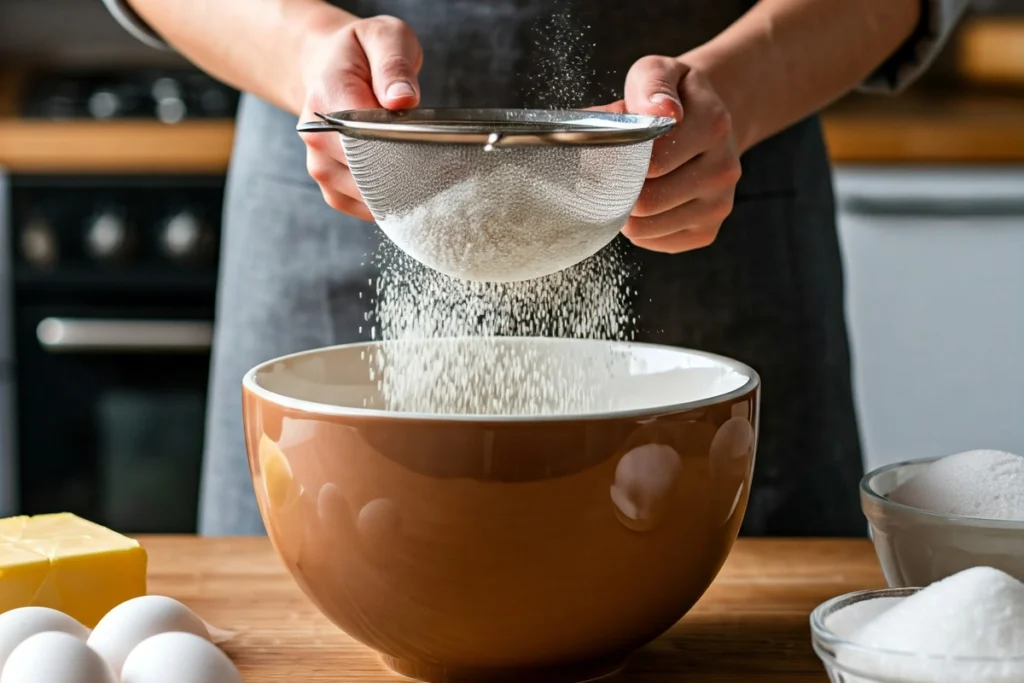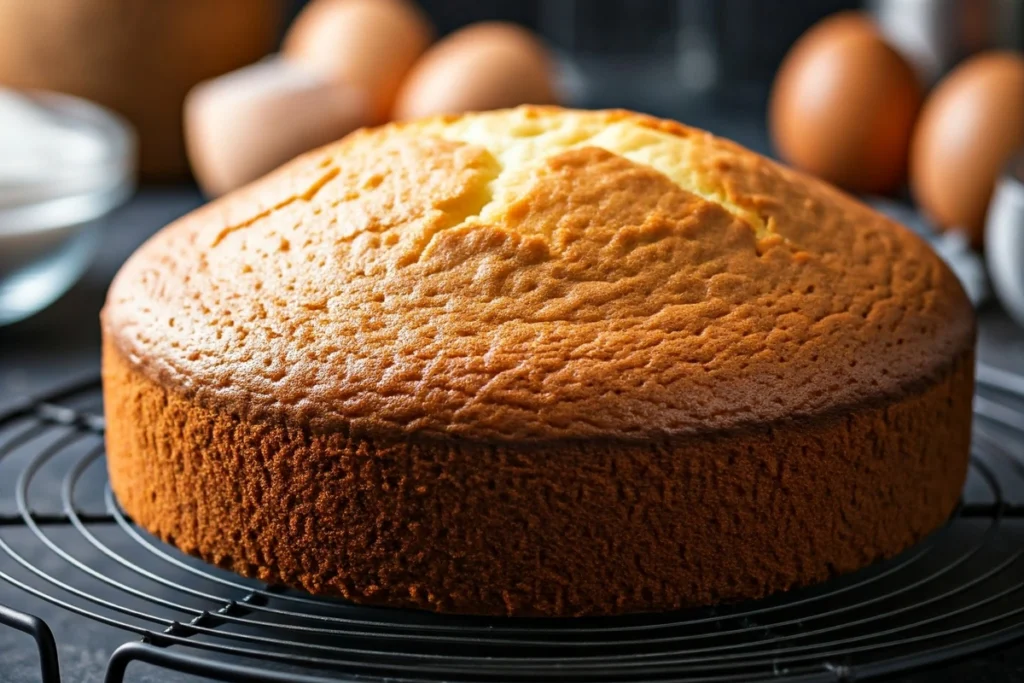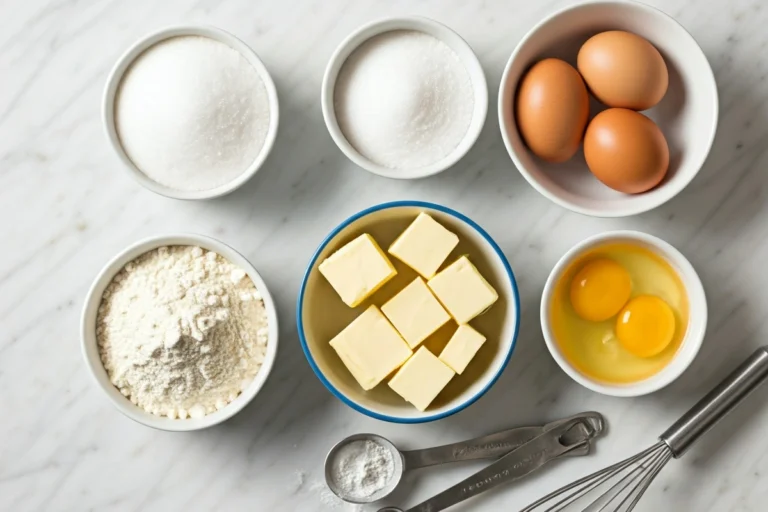Baking a cake may seem like a simple task, but every great cake relies on the perfect blend of essential ingredients. Each plays a unique role, ensuring the cake rises, holds its shape, and tastes delightful. So, what are the 5 main ingredients in cake? They are flour, sugar, eggs, fat, and leavening agents. These components form the foundation of nearly every cake recipe, from classic vanilla to rich chocolate layers.
In this guide, we’ll dive deep into these fundamental ingredients, their roles, and how they contribute to the perfect bake. Along the way, we’ll share tips, substitutions, and answers to common baking questions to ensure your next cake is a hit.
Introduction to Cake Ingredients
Why Understanding Cake Ingredients Matters
When it comes to baking, understanding your ingredients is half the battle. Each element in a recipe serves a purpose—flour builds the structure, sugar sweetens and stabilizes, while eggs bind and provide lift. Knowing what are the 5 main ingredients in cake allows you to make better choices, whether you’re experimenting with flavors, accommodating dietary restrictions, or troubleshooting a baking mishap.
Take a sponge cake, for instance. Without eggs, it wouldn’t have that fluffy texture. Skip the sugar, and the cake loses its moisture and caramelized sweetness. These are just a few examples of how essential each ingredient truly is.
An Overview of the Five Key Ingredients
The five essential cake ingredients—flour, sugar, eggs, fat, and leavening agents—are the backbone of cake-making. Flour provides structure, while sugar does more than sweeten; it also adds moisture and stabilizes. Eggs are multitaskers, offering structure, moisture, and richness. Fat, whether butter or oil, lends flavor and keeps the cake tender. Lastly, leavening agents like baking powder or soda ensure your cake rises to fluffy perfection.
Flour – The Foundation of a Cake
Types of Flour Commonly Used in Cakes
Flour is the backbone of any cake recipe, and its type greatly influences the final product. All-purpose flour is the most versatile and commonly used for cakes, providing a balanced structure and texture. Cake flour, however, contains less protein, making it ideal for soft, tender cakes like sponge or angel food. For gluten-free cakes, almond flour, coconut flour, or rice flour serve as excellent substitutes.
How Flour Affects Texture and Structure
When combined with liquids, flour forms gluten, which provides the cake with its structure. The amount of gluten varies depending on the type of flour used. Cake flour creates a delicate crumb, while bread flour—though rarely used—would make a denser, chewier cake. Balancing the amount of flour with other ingredients ensures the right texture and avoids dryness.
Substitutes for Flour in Baking
Wondering what are the 5 main ingredients in cake if you’re avoiding traditional flour? Options like oat flour, chickpea flour, and even finely ground nuts can replace wheat flour in many recipes. These alternatives often require adjustments in liquid ratios, so be sure to follow tested recipes when experimenting.

For more detailed tips on choosing the right flour for specific cake types, consider checking this guide on cake textures for additional insight.
Sugar – The Sweetener and Stabilizer
Different Types of Sugar for Cakes
Sugar isn’t just about sweetness—it’s a multitasking ingredient in cake baking. Granulated sugar is the most common, but brown sugar adds moisture and a rich, caramel flavor to recipes. Confectioners’ sugar is used for icings, while superfine sugar dissolves quickly, making it perfect for delicate cakes like chiffon or sponge.
The Role of Sugar Beyond Sweetness
In addition to sweetening, sugar contributes to browning, moisture retention, and structure. It interacts with fat and liquid ingredients to create a smooth batter and prevents gluten overdevelopment, ensuring the cake remains soft. Sugar also caramelizes during baking, forming a golden crust that adds flavor and visual appeal.
Alternatives to Sugar in Cake Baking
If you’re avoiding traditional sugar, there are plenty of substitutes to explore. Honey, maple syrup, and agave nectar add natural sweetness, while stevia and erythritol are popular for low-calorie bakes. These alternatives may affect the texture, so it’s crucial to use recipes designed for them.
Curious how sugar interacts with other ingredients in your cake? Dive deeper into expert baking tips here.
Eggs – The Bind and Rise Hero
How Eggs Contribute to Cake Structure
Eggs play a starring role in most cakes, offering structure, richness, and moisture. When beaten, egg whites incorporate air, providing lift and fluffiness. Meanwhile, yolks contribute fat and emulsifiers, creating a velvety texture. Together, these components bind the other ingredients, ensuring a cohesive and stable cake structure.
The Role of Egg Yolks vs. Egg Whites
Egg yolks are rich in fats and proteins, giving cakes their tender crumb and deep color. They also act as an emulsifier, helping water and fat blend seamlessly. Egg whites, on the other hand, are primarily protein and water. When whipped, they create a foam that captures air, essential for light cakes like angel food or chiffon.
Substitutes for Eggs in Cakes
For those avoiding eggs, there are plenty of alternatives. Applesauce, mashed bananas, or yogurt can replace eggs in dense cakes. Flaxseed meal mixed with water is a popular vegan option, mimicking the binding properties of eggs. Aquafaba (chickpea water) is another choice, especially for recipes requiring whipped egg whites.
Looking for more tips on creating egg-free cakes? For inspiration, explore other creative cake recipes at Goldy Recipe.
Fat – Butter, Oil, or Margarine?
Why Fat is Crucial for Moisture and Flavor
Fat is one of the unsung heroes in what are the 5 main ingredients in cake. It coats the flour’s protein molecules, limiting gluten formation, and creates a tender, moist crumb. It also adds richness and enhances the cake’s flavor profile, ensuring every bite is indulgent and satisfying.
Choosing the Right Fat for Your Cake
The choice between butter, oil, or margarine depends on the desired texture and flavor. Butter lends a rich, creamy taste and contributes to a light, fluffy texture when creamed with sugar. Oil, being liquid at room temperature, creates cakes with a moist, dense crumb, making it ideal for recipes like carrot cake. Margarine, while less common in modern baking, is a cost-effective substitute with a similar texture to butter.
Healthier Alternatives to Traditional Fats
If you’re looking for healthier options, consider substituting traditional fats with unsweetened applesauce, Greek yogurt, or avocado puree. These alternatives lower fat content while retaining moisture and adding a nutritional boost.
For more ideas on experimenting with different fats in baking, check out additional recipes at Goldy Recipe.
Leavening Agents – The Rise Makers
Understanding Baking Powder, Baking Soda, and Yeast
Leavening agents are the unsung heroes of what are the 5 main ingredients in cake. They ensure your cake rises beautifully, giving it a light, airy texture. Baking powder is a double-acting leavener, releasing carbon dioxide during mixing and baking. Baking soda, on the other hand, works with acidic ingredients like buttermilk or vinegar to produce gas bubbles. Yeast, though less common in cakes, is used in recipes like yeast-raised coffee cakes, adding a unique flavor and texture.
How Leavening Agents Work in Cakes
These agents produce carbon dioxide when they interact with heat or acids, creating air pockets that expand in the oven. This process makes cakes fluffy and prevents them from being dense or heavy. Correctly measuring leavening agents is crucial—too much can cause a cake to rise and collapse, while too little results in a flat, dense texture.
Natural Leavening Options for Cakes
If you’re looking for natural alternatives, whipped egg whites can serve as a leavening agent, particularly in recipes like sponge cakes. Yogurt and buttermilk, combined with baking soda, also create an effective, natural lift.
Balancing the Five Main Ingredients
The Science Behind Perfect Cake Ratios
The balance of ingredients is essential in understanding what are the 5 main ingredients in cake. Flour provides structure, sugar adds moisture and sweetness, eggs bind, fat tenderizes, and leavening agents lift. The right ratios prevent a cake from being too dry, too dense, or prone to collapsing. Most recipes follow a basic rule: the weight of sugar should equal the weight of flour, while eggs and fat should balance each other.
Common Mistakes When Measuring Ingredients
Baking is a science, and precision is key. Over-measuring flour can make a cake dry, while too much sugar can lead to a sunken center. Always use a kitchen scale for accuracy and level off dry ingredients with a knife. Missteps in measuring leavening agents or liquids can also throw off the texture and taste, so double-check measurements before mixing.
Variations and Additions Beyond the Basics
Enhancing Flavor with Additions like Vanilla and Cocoa
While what are the 5 main ingredients in cake form the backbone of any recipe, additional ingredients like vanilla extract and cocoa powder elevate flavor. Vanilla enhances sweetness and adds depth, making it a staple in most cake recipes. Cocoa, on the other hand, brings richness and is essential for chocolate cakes. These additions are easy to incorporate and can transform a basic cake into something extraordinary.
Incorporating Fruits, Nuts, and Spices
Fruits, nuts, and spices take cakes to the next level. Fresh or dried fruits like strawberries, blueberries, and raisins add natural sweetness and texture. Nuts like almonds and walnuts provide crunch, while spices like cinnamon, nutmeg, and cardamom enhance the aroma. These ingredients allow bakers to customize cakes for specific occasions or preferences.
Creative Twists on Traditional Cakes
Experimenting with different flavors and textures is a fun way to explore cake-making. Try adding coffee for a mocha twist, or swirl caramel into the batter for a marbled effect. For festive occasions, mix in sprinkles or colorful fruit purees to brighten up the cake. These creative additions keep baking exciting and versatile.
For inspiration, check out more ideas on creative cake designs.
Frequently Asked Questions About Cake Ingredients
What Happens if You Skip One Ingredient?
Each of the five main ingredients serves a unique role, so skipping one can drastically alter the outcome. Without flour, the cake loses its structure. No eggs? The batter won’t bind, and the cake will crumble. If sugar is omitted, the cake will be dry and flavorless. Always understand how substitutions or omissions impact your recipe to ensure success.
Can You Swap Ingredients in a Recipe?
Yes, many ingredients can be swapped, but results may vary. For example, plant-based milk can replace dairy milk, and applesauce or mashed bananas can substitute eggs. However, these changes often require adjustments to other ingredients to maintain the right texture and flavor.
How Do Ingredients Affect Cake Shelf Life?
Ingredients like sugar and fat play a role in preserving cakes. Sugar retains moisture, while fat slows staling. Cakes with high-fat content or added syrups tend to last longer, while those with fresh fruits or whipped cream require refrigeration and have shorter shelf lives.

Understanding what are the 5 main ingredients in cake and their effects helps you bake cakes that are not only delicious but also tailored to your needs. Keep experimenting and learning for even better results in your baking adventures!

